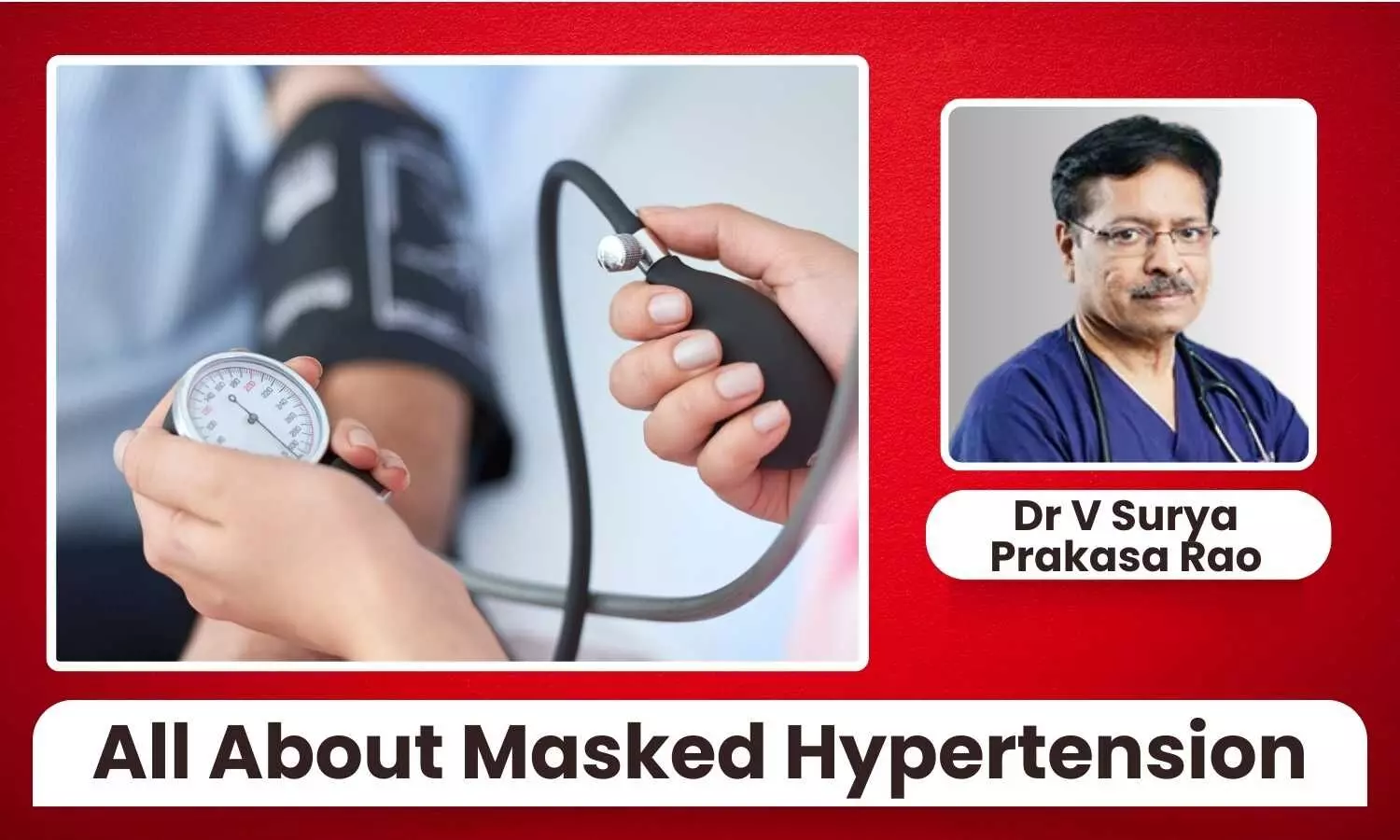Masked Hypertension: Why Normal BP Readings Could Still Mean Trouble - Dr V Surya Prakasa Rao

You enter a clinic for a normal check-up. Your blood pressure is measured. It's within usual limits. You walk away feeling reassured. But what if that one reading did not convey the entire story?
What if your blood pressure rises silently and without warning at home, work, or on your regular commute? Welcome to the realm of masked hypertension, a concealed illness with serious repercussions.
What is Masked Hypertension?
Most people are familiar with the idea of high blood pressure, sometimes known as hypertension. Traditionally, a diagnosis is given when your clinic reading consistently exceeds a certain threshold.
However, not all elevated blood pressures are detected during a doctor's appointment. In fact, some people have normal blood pressure in clinics but routinely higher readings outside of them. This is called masked hypertension, since it hides in plain sight.
Masked hypertension is more harmful than white coat hypertension, which occurs when blood pressure rises briefly as a result of worry in a medical setting.
It refers to a persistent increase in blood pressure during normal living, whether at home, at work, or while sleeping. That means your heart, blood vessels, and kidneys may be under ongoing strain, even if everything appears normal during a fast clinic visit.
Why is this a problem?
The risk is in the illusion of wellness. Patients with masked hypertension frequently go undetected for years. They may feel absolutely fine, and their occasional doctor appointments do not raise any concerns.
Behind the scenes, however, their organs are being impacted. Uncontrolled high blood pressure can gradually damage the heart, harden the arteries, raise the risk of stroke, impair vision, and endanger the kidneys.
Furthermore, because no therapy is commenced, this group of people may be at a higher risk than those who have been correctly diagnosed and treated for hypertension. By the time issues arise, damage may have already been done.
Who is at Risk?
You might question why this happens. Who should be worried?
Several factors can raise your risk of having masked hypertension. Diabetes, obesity, sleep disorders (such as sleep apnoea), a family history of hypertension, or chronic stress are also risk factors. Smokers, those who lead sedentary lifestyles, and those who consume a lot of salt may also be at greater risk.
It is also more common among young people or working professionals who are subjected to high-pressure situations or shift work. Their stress responses are stimulated throughout the day, causing sporadic but constant elevations in blood pressure that might cause long-term injury.
Why Clinic BP Monitoring Is Not Always Enough
Blood pressure is typically monitored once or twice during a doctor's visit. This is normal, although it has restrictions. The problem with these rare readings is that they do not accurately reflect your blood pressure throughout the day.
They miss out on fluctuations, patterns, or surges that occur when travelling through traffic, dealing with deadlines, or watching a competitive game on TV.
Some people get a false sense of control when their blood pressure drops in a calm atmosphere like a clinic. Others may have blood pressure increases while sleeping, which is another type of disguised hypertension that remains undiagnosed unless particularly monitored.
Role of Ambulatory Blood Pressure Monitoring (ABPM)
This is where ambulatory blood pressure monitoring (ABPM) comes in. The ABPM test measures your blood pressure over the course of a day.
A small gadget is strapped to your arm and worn all day and night, capturing readings at regular intervals—during work, meals, sleep, and even in stressful situations. This provides a complete view of your blood pressure cycle, allowing you to discover patterns that would otherwise go unreported.
Individuals with borderline readings, those with organ damage that has no clear explanation, or patients who are already at high cardiovascular risk can benefit from ABPM. It brings clarity, aids in early discovery, and can direct specific treatment options.
How is it managed?
If masked hypertension is identified, therapy is similar to that for diagnosed hypertension. The first line of defence is to make lifestyle adjustments such as limiting salt intake, maintaining a healthy weight, controlling stress, implementing regular physical activity, and getting enough sleep.
In many circumstances, medication may be provided depending on specific risk factors.
Importantly, treatment is more than merely lowering monitor numbers; it is also about protecting the brain, heart, kidneys, and eyes against long-term damage. Masked hypertension can be managed with regular checkups and home blood pressure monitoring.
Note to Indian Readers
Although high blood pressure is becoming more widely known in India, concealed hypertension is still rarely discussed.
Our tendency to seek treatment only when symptoms appear, or to rely on irregular health checkups, exacerbates the problem. Many Indian patients still believe that hypertension primarily affects the elderly or those who are physically ill, which delays diagnosis.
This makes it even more crucial to take a proactive approach, especially if you have additional risk factors. Even if your numbers appear to be "normal," don't dismiss warning symptoms such as persistent fatigue, headaches, or shortness of breath with effort. They may be pointing to a deeper problem.
Masked hypertension is a secret health issue that requires more attention. If your blood pressure is normal in the clinic, but you have additional risk factors—or simply a strong gut feeling that something is wrong—it is worth investigating further.
Ambulatory monitoring is a safe and straightforward technique that offers clarity and peace of mind.
If you are concerned about your heart health or want to know if your blood pressure levels accurately reflect your risk, consult your doctor. Do not wait for symptoms. Prevention begins with awareness, which begins with the appropriate test.


